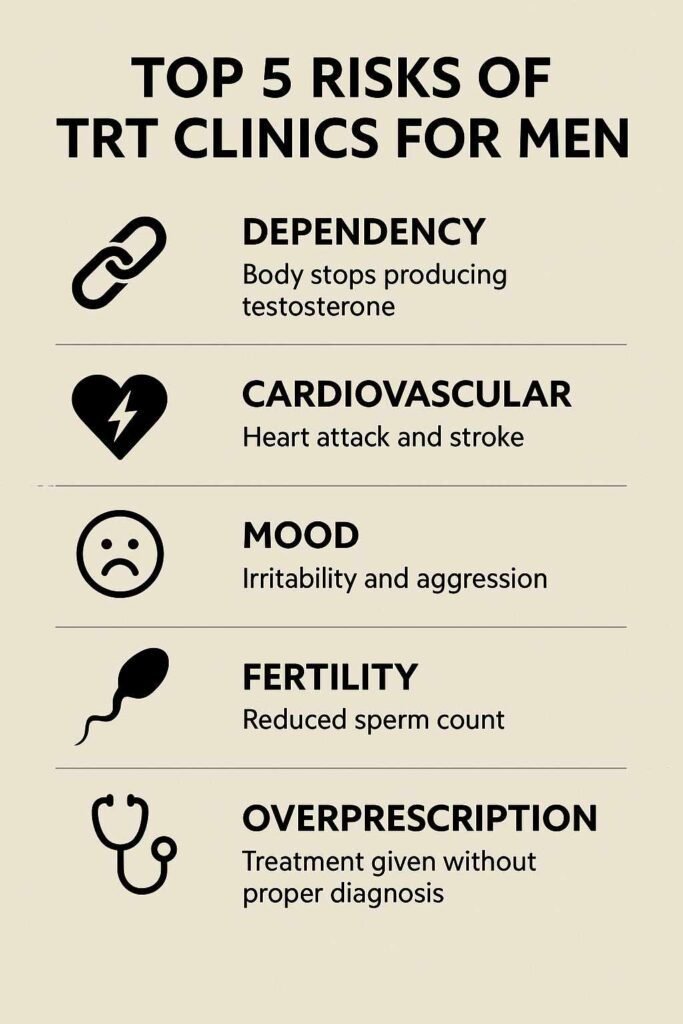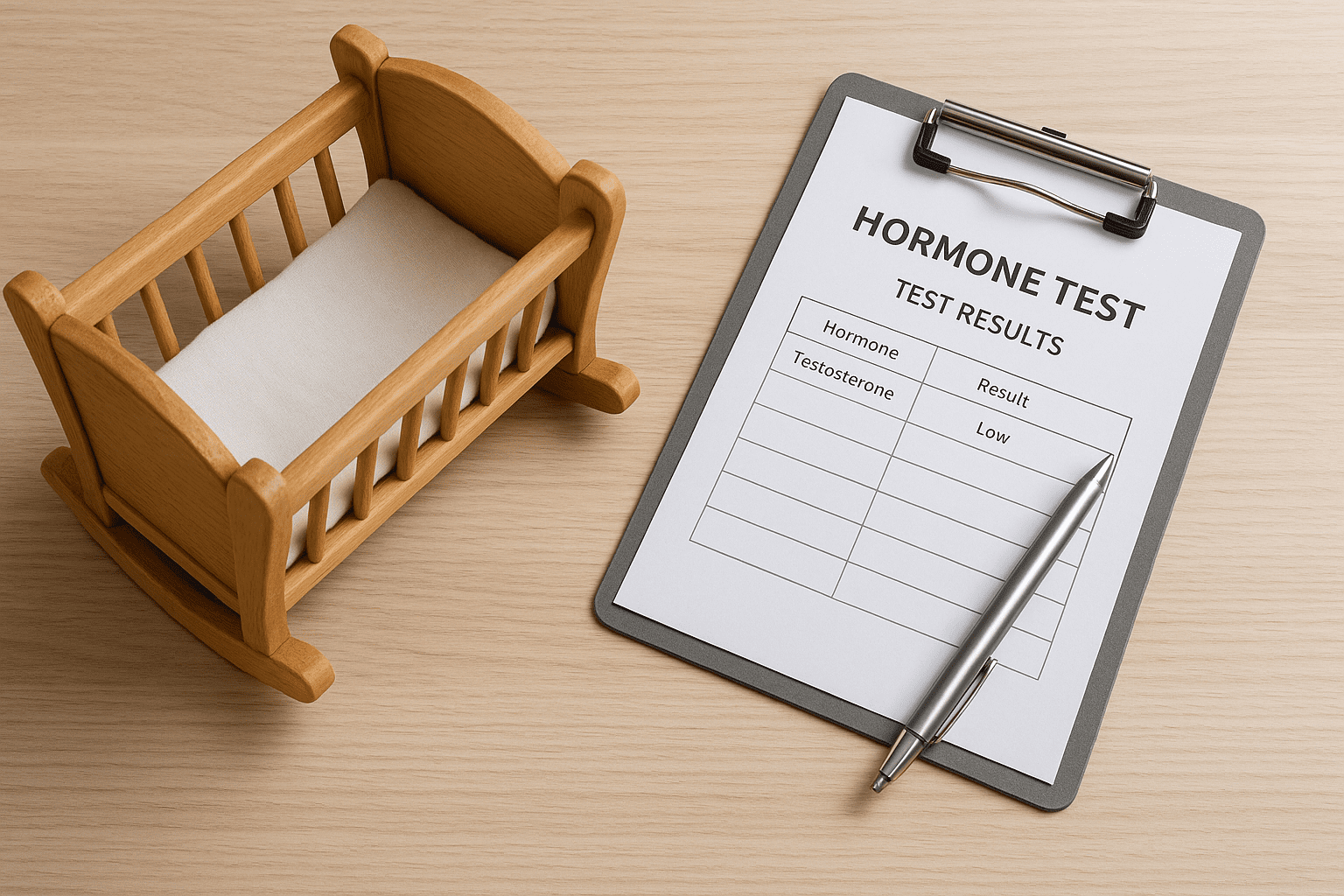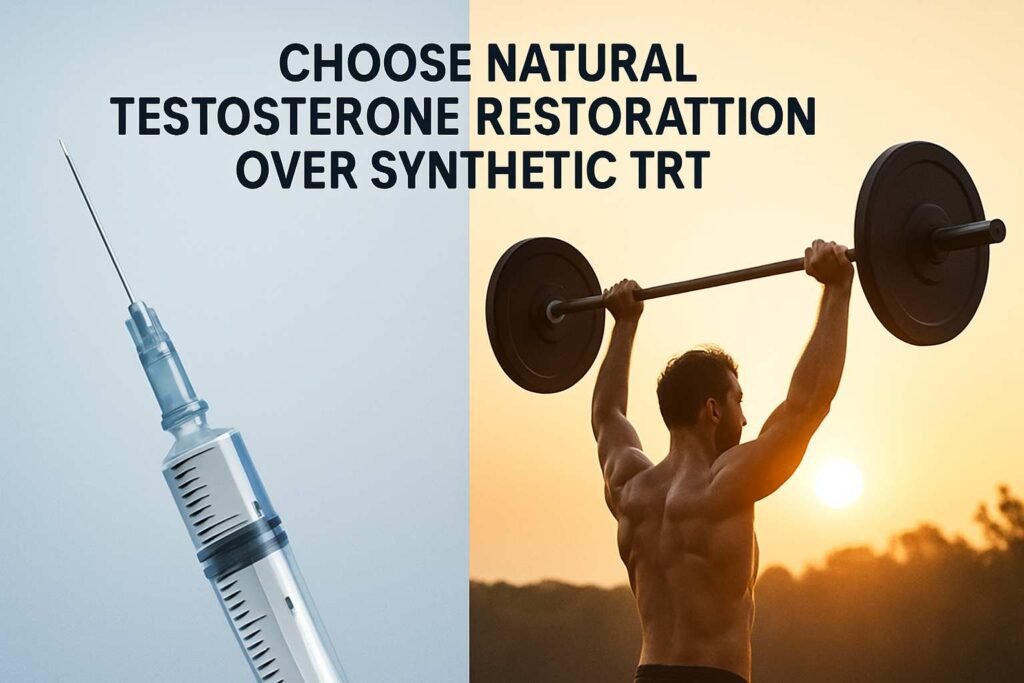Introduction
TRT clinics’ risks aren’t just medical fine print; they’re the main event. And yet, if you scroll through your average social media feed, you’d think testosterone injections are the modern man’s holy grail. All gain, no pain. Instant masculinity in a syringe.
Here’s the truth: most clinics won’t put on a billboard: what looks like a shortcut to vitality could be a long-term lease on hormonal dependency. This isn’t just about your T levels; it’s about the system selling you a solution that may ignore your root issues while quietly signing you up for lifelong meds.
Sure, some guys feel amazing after TRT, initially. But many others report mood swings, cardiovascular scares, fertility loss, and the subtle realisation that they’re now a customer for life.
This isn’t fear-mongering. It’s about informed choice. And if your clinic treats you like a subscription, not a human being, maybe it’s time to unsubscribe, or at least read the terms & conditions.
Let’s break down the five real risks every man should know before hopping on the testosterone bandwagon.
Testosterone replacement therapy clinics are popping up faster than kombucha stands in Brooklyn. And while some men walk away with renewed vitality, many more are left with side effects, financial drain, and a hormone rollercoaster they didn’t sign up for. If you’ve been tempted to “boost your T” the clinical way, this is your cue to pause and get informed.
The phrase “trt clinics risks” is rarely mentioned at the start of your biohacking journey, yet it’s exactly where it should begin. Because between the flashy Instagram reels and doctor-in-a-box startups, there’s a growing gap between what men are being promised and what they’re actually getting. This article breaks that gap down.
Table of Contents
Why This Matters Now
Let’s not beat around the bush, the rise of TRT clinics is no coincidence. Testosterone Replacement Therapy has become the modern man’s midlife multivitamin, marketed with the subtlety of a monster truck rally.
In 2023 alone, the global testosterone market hit $2.6 billion, according to Grand View Research, with clinics popping up in every zip code promising “optimised manhood.” But here’s the thing: men aren’t broken. We’re exhausted, underslept, over-caffeinated, and overexposed to screens and stress. The real problem? Most of us are being sold a biochemical Band-Aid for what’s really a lifestyle haemorrhage.
And let’s not ignore the influencer effect. Your favourite fitness bro just dropped a video titled “How TRT Changed My Life”, conveniently omitting the post-cycle therapy, mood crashes, or the tiny little fact that his balls are now decorative.
This article isn’t about shaming, it’s about waking up. Before you give your T levels to the highest bidder, let’s explore why being informed is the most masculine move you can make today. Talk about the elephant in the gym: Testosterone Replacement Therapy (TRT) clinics are booming, and not always for the right reasons. If your social feed has been whispering that injecting T is the fast lane to manhood 2.0, you’re not alone. According to a 2023 study by JAMA Internal Medicine, prescriptions for testosterone have increased fivefold in the past decade. The kicker? Up to 40% of those men never had clinical hypogonadism to begin with.
TRT is serious medicine, but it’s been marketed like a gym supplement. That’s a problem. Because while some men truly benefit from medically-supervised TRT, many others are being sold a shortcut to masculinity by clinics more interested in subscriptions than solutions.
Let’s dig into the real risks, not to scare you, but to help you make a decision rooted in clarity, not clever Instagram ads.

Risk 1: Hormonal Dependency
What it is:
Once you start TRT, your body may reduce or completely shut down its own testosterone production. That means you may need to stay on TRT for life.
Why it matters:
Most clinics gloss over this part. They sell “freedom,” but rarely mention the biological leash. Your testicles literally shrink in response to exogenous testosterone. It’s not metaphorical, it’s physiological.
Supporting Fact:
The Endocrine Society notes that prolonged TRT use suppresses the hypothalamic-pituitary-gonadal (HPG) axis, reducing endogenous testosterone and sperm production.
The Endocrine Society on HPG axis suppression
Tool / Resource:
Ask your clinic for a restart protocol before you begin; if they don’t have one, run.
“The Daily Testosterone System: Sleep, Light, and Movement Aligned” →
Risk 2: Cardiovascular Concerns
What it is:
TRT can increase red blood cell count and thicken the blood, which may elevate the risk of heart attack or stroke.
Why it matters:
While some studies suggest TRT helps certain men with metabolic syndrome, others link it to increased cardiovascular events, especially when misused.
Supporting Fact:
A meta-analysis in PLOS One (2022) found that men over 45 using TRT had a 21% increased risk of cardiovascular events.
Tool / Resource:
Get regular hematocrit and lipid panel tests. No lab checks = red flag.
Risk 3: Mood Instability & Emotional Blunting
What it is:
TRT may boost mood or tank it. Some men report increased aggression, irritability, or emotional numbness.
Why it matters:
You might think testosterone = confidence. But it’s more complex. Neurosteroid shifts can unbalance serotonin and dopamine pathways.
Supporting Fact:
A 2021 study from Frontiers in Psychiatry showed links between synthetic hormone modulation and increased emotional dysregulation in men under 40.
Frontiers in Psychiatry, 2021 study on neurohormonal impacts
Tool / Resource:
Track mood with an app like Moodpath or Bearable during the first 12 weeks.
Risk 4: Fertility Shutdown

What it is:
TRT significantly lowers sperm count, often to zero.
Why it matters:
If you’re thinking of having children in the next 2–3 years, TRT could close that door unless it’s paired with fertility-preserving strategies.
Supporting Fact:
UCLA Health reports that up to 90% of men on TRT experience azoospermia (no sperm in semen).
UCLA Health on TRT and fertility
Tool / Resource:
Consider hCG injections or clomiphene citrate under supervision to preserve fertility.
“4 Hidden Steps in the Low-T Detox Challenge” →
Risk 5: Clinic Culture & Overprescription
What it is:
Many TRT clinics operate like subscription-based startups, prioritising repeat billing over responsible medicine.
Why it matters:
Some clinics skip baseline hormone panels, ignore root causes (sleep, stress, obesity), and push one-size-fits-all protocols.
Supporting Fact:
An undercover investigation by NBC News in 2023 found that 3 out of 5 clinics offered TRT prescriptions after just a short questionnaire, no physical, and no full labs.
NBC News investigation on TRT clinics
Tool / Resource:
Ask: Do they review your sleep, weight, cortisol, and thyroid before suggesting TRT? If not, it’s marketing, not medicine.
Conclusion
TRT isn’t evil. But the current hype around it? That’s where the danger lies.
If you’re truly suffering from low-T (clinically diagnosed, not TikTok self-diagnosed), then medical TRT may help, under careful guidance. But if you’re looking to feel stronger, clearer, and more vital, don’t skip the fundamentals: sleep, light, strength, and nourishment.

If you found this helpful, check out our guide: “7 Savage Ways to Boost Testosterone Naturally Daily”, no injections required.
Stay sharp. Ask better questions. Reclaim your biology.
, Tegar Hafizhal
Suggested Articles
1. 7 Savage Ways to Boost Testosterone Naturally Daily
No needles, no scripts, just proven lifestyle tools that work.
2. The Daily Testosterone System: Sleep, Light, and Movement Aligned
A step-by-step system to restore energy and focus without hormonal shortcuts.
3. 4 Hidden Steps in the Low-T Detox Challenge
How to reset your testosterone and ditch toxic daily habits.
4. The Masculine Discipline System: Daily Structure for Mental Sharpness
Structure isn’t boring, it’s your hormonal secret weapon.
5. Testosterone 101: What Every Man Should Know But Was Never Taught
A back-to-basics guide to understanding your most powerful male hormone.


